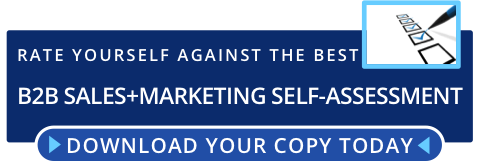 But there’s a potential problem: any organisation, any stakeholder, always has many more issues that they would like to address than they could possibly have the have money, time, or inclination to deal with.
But there’s a potential problem: any organisation, any stakeholder, always has many more issues that they would like to address than they could possibly have the have money, time, or inclination to deal with.
That’s why so many issues stimulate so many apparently positive sales conversations that end up going absolutely nowhere. The prospect is interested enough to talk, but not motivated enough to act...
One of the ways of dealing with this, of course, is to really dig into the cost of inaction, and to persuade the prospect that the cost and risk of sticking with the status quo is worse than the cost and risk of change.
Another is to associate the issue with an already-funded corporate initiative that has the attention of the senior executive team, and to position your solution as a key tool to support the initiative.
How are they coping today?
These are both effective strategies under the appropriate circumstances. But there’s another simple strategy that is usually worth exploring and testing - how are they coping with the issue today?
Unless the issue has emerged recently, or unless you have managed to uncover a previously unrecognised or underappreciated problem, if they are already aware of a potentially critical business issue they are probably already trying to do something about it at some level in the organisation.
It may be a formally funded project, but it’s often just as likely to be a work-around or local initiative of some sort. But either way, the fact that they have reacted means that they already recognise the need to do something.
Looking for the imperfect fix
It’s just that whatever they are doing today probably isn’t a perfect fix. It almost certainly has its shortcomings. Now, they might not yet be prepared to acknowledge them directly until they know you better, but intelligent questioning can often give you some clues.
This is where a question along the lines of “so if you were rating your company’s current ability to address the issue on a 1-10 scale, where 10=perfect, what score would you give?” followed by “so - what would have to change for you to give it a 10?” can be so powerful.
The psychology is important: if you ask the question the right way, unless the current situation is truly perfect, they are unlikely to give it a 10. And the question about what would have to change to make it so usually causes them to think.
Room for improvement
Their response will usually give you clues about where you can best focus the subsequent discussion. What is it about their current “solution” that they would like to see improved? Or what is it that might be holding their current initiative back?
What is it about your approach that could help them get the results they need? This, by the way, is not the time to dive into the minutiae of the “solution” you are eventually going to propose to them.
Far better to concentrate on what it is that sets your approach apart from the current way they are trying to tackle the issue. Start by focusing on what makes you different. There will be plenty of time later for you to explain what makes you better.
The power of a realistic story
Customer anecdotes can be incredibly powerful here, but to be most effective, they need to take the listener on a journey - preferably one they can strongly relate to. The more your story describes a similar role in a similar organisation, the better. The more measurable the outcomes, the better.
The more realistic the story, the better. Everyone who likes in the real world knows that there are few “miracle cures”. They know that people and organisations often need to ride a bumpy learning curve before they achieve the results they are looking for.
They also know - perhaps they have become more aware with your help - that there is probably a better way of addressing the critical business issue they have been wrestling with. That’s where your organisation’s experience can be so powerfully positioned.
Focusing on the workarounds that aren't working
And that’s why focusing on workarounds that aren’t working - or initiatives that are incomplete - can be such a powerful strategy. You’re not have to sell them on the idea that action is required - you’re simply trying to persuade them that their success is measurably more likely if they choose to partner with you.



![[Research Round-Up] The Latest From NetLine On B2B Content Consumption](https://customerthink.com/wp-content/uploads/email-g56aa02a47_1280-pixabay-email-marketing-218x150.png)
